There Will Be Flood
Air Date: Week of May 1, 2009
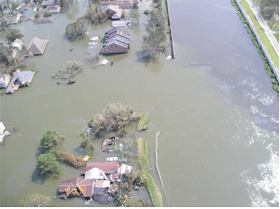
The 17th Street Canal Breach. (Photo: IPET)
New Orleans residents have been waiting for the official word on why the levees failed in the aftermath of Hurricane Katrina and have been hoping for assurance that they won’t fail again. What they got was a dense report from the Army Corps of Engineers. Host Steve Curwood asks David Moreau from the National Academies of Science to help make sense of the recent government report. The bottom line: people in flood prone areas will get wet.
Transcript
CURWOOD: As if the young Obama Administration didn’t have enough to contend with, it also inherited the problems of New Orleans and Louisiana in the wake of Hurricane Katrina. Much of Gulf region still faces dire threats from flooding should another storm strike.
Shortly after Katrina, Ivor van Heerden, the deputy director of the Louisiana State University Hurricane Center was among those who urged authorities to rethink the levee system. He suggested that their protected areas should be scaled back, but also made stronger where they protect core areas including downtown New Orleans.

Ivor Van Heerden
CURWOOD: How many people right now live outside the protected system you're talking about?
VAN HEERDEN: It probably amounts to maybe 100,000 at the most. The bottom line in all of this is as you plan it has to be a case of not what's good for me, but what's good for the most folk, what’s good for everybody, what makes the best sense for the overall population in coastal Louisiana.
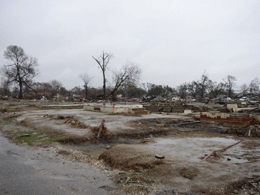
The Lower Ninth Ward in January 2006, about five months after Katrina. (Photo: David Moreau)
The interagency task force, known by its acronym IPET also found fault with some of the Army Corps’ engineering practices. University of North Carolina professor David Moreau was part of the National Academy review.
MOREAU: The report is remarkably candid in several places. Particularly candid in terms of its assessment of the failure along the 17th street canal which led to the flooding of a major portion of the central city. So there’s nothing being papered over there. Whether it’s this report or the general information about what happened during Katrina, there will be a very significant change in the design of protective facilities. There will be a substantial change in how the risk is communicated. The committee recommended that in fact the IPET staff actually hire a firm that specializes in communicating with the public to take the findings and translate those into common, everyday language.
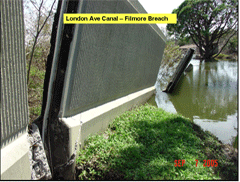
(Photo: IPET).
MOREAU: The 100 year return year period is an average return period. But there’s a very substantial likelihood that that during a thirty-year mortgage that if you in fact knew exactly what the likelihood was it would be around 25, 27 percent.
CURWOOD: So, wait a second – if I were told that over the life of say owning a house it had a 27 percent chance of getting flooded out, that doesn’t seem like acceptable odds.
MOREAU: It’s not. For a place like New Orleans, it’s totally unacceptable. The real message is if you live in areas that are below sea level – you’re at risk. And you should exercise caution, should be prepared for failures if they occur.
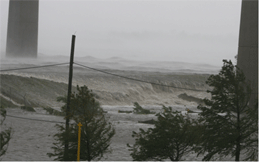
Overtopping along Gulf Intracoastal Waterways. (Photo: IPET)
MOREAU: Well, the suggestion is impractical if you put it in terms of prohibition. What you could do, and should do, in my opinion, is to avoid building facilities that give people a false sense of security. That we’re talking here in a report addresses the fact that there are 350 miles of protective structures around New Orleans. I’m not sure the language that we used, but I’ll say it’s a virtual impossibility to ensure that all 350 miles of that system are going to be fully functional a hundred percent of the time.
CURWOOD: In other words, in certain areas say, there is no effective flood protection here – be here at your own risk.
MOREAU: That’s right.
CURWOOD: Well, at this point we know that the cost of the Katrina floods is at some place north of $80 billion.
MOREAU: Right.
CURWOOD: So, if we had spent $80 billion on flood protection at least it would have provided jobs and people wouldn’t have died and lost so much ground, and social and emotional, as well as financial capital.
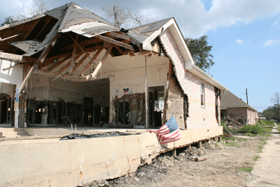
A home trashed by the 17th Street Canal breach.
CURWOOD: And for 80 billion bucks, do you think we could protect New Orleans?
MOREAU: For 80 billion bucks you could do a lot of other things that might be a lot more beneficial than rebuilding levees or making them higher. You might be able to relocate people. You might be able to create jobs in areas that are substantially at less risk. It requires some additional analysis that has not yet been publicly released.
CURWOOD: Professor David Moreau, thank you so much.
MOREAU: Thank you, Steve.
Links
For more on David Moreau, click here.
Check out the Living on Earth series on Lousiana storm protection.
Living on Earth wants to hear from you!
Living on Earth
62 Calef Highway, Suite 212
Lee, NH 03861
Telephone: 617-287-4121
E-mail: comments@loe.org
Newsletter [Click here]
Donate to Living on Earth!
Living on Earth is an independent media program and relies entirely on contributions from listeners and institutions supporting public service. Please donate now to preserve an independent environmental voice.
NewsletterLiving on Earth offers a weekly delivery of the show's rundown to your mailbox. Sign up for our newsletter today!
 Sailors For The Sea: Be the change you want to sea.
Sailors For The Sea: Be the change you want to sea.
 The Grantham Foundation for the Protection of the Environment: Committed to protecting and improving the health of the global environment.
The Grantham Foundation for the Protection of the Environment: Committed to protecting and improving the health of the global environment.
 Contribute to Living on Earth and receive, as our gift to you, an archival print of one of Mark Seth Lender's extraordinary wildlife photographs. Follow the link to see Mark's current collection of photographs.
Contribute to Living on Earth and receive, as our gift to you, an archival print of one of Mark Seth Lender's extraordinary wildlife photographs. Follow the link to see Mark's current collection of photographs.
 Buy a signed copy of Mark Seth Lender's book Smeagull the Seagull & support Living on Earth
Buy a signed copy of Mark Seth Lender's book Smeagull the Seagull & support Living on Earth

